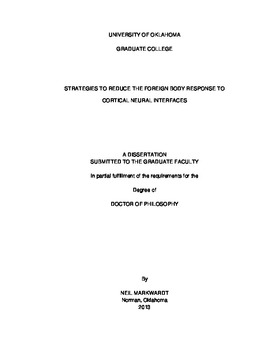| dc.description.abstract | Cortical neural interfaces offer unique capabilities to researchers and physicians, opening doors to superior understanding and treatment of a host of processes and diseases in the central nervous system. One of modern medicine’s greatest challenges stems from the inability of the nervous system to heal following disease or injury, and neural interfaces combined with modern electronics offer significant potential to help patients regain lost function. Current interface technologies fall short of the long term performance that is necessary to be useful in the clinical setting, due in large part to the brain’s immune reaction to current implanted neural interface devices. This reaction leads to the death of neurons surrounding the implant, formation of a fibrous glial scar, and eventual loss of neural signals.
This dissertation presents the results of three different studies which evaluated strategies to mitigate the foreign body response and its detrimental effects on implanted neural interfaces. Modifications were made to the implantation scheme, porosity, and substrate material of cortical recording probes, and these modifications were tested to quantify their effects on the foreign body response. The first study examined the relationship between cortical implants and the meninges, and whether the placement of the implants fully below the cortical surface would reduce meningeal contributions to the immune reaction. Sub-meninges implants were found to elicit a significantly reduced glial cell reaction compared to trans-meninges implants, which suggests the presence of a significant meningeal cell contribution to the immune reaction and motivates the development of fully wireless recording probes which can be implanted entirely below the cortical surface.
The second study evaluated a scheme to take advantage of the above phenomenon in a manner compatible with current interface technology. A series of holes was added to the shank of a planar neural implant near the level of the cortical surface, in order to allow the regrowth of meningeal tissues through the implant structure and discourage migration down the implant shaft. The addition of this feature was found to significantly reduce meningeal tissue levels and improve mean neuron density as well at 4 weeks post implantation.
In the final study, histological evaluation of a recently developed dynamically softening polymer neural interface substrate was performed. Dynamically softening implants were compared to parylene-c implants which possessed a similar initial modulus but lacked softening capability. The addition of dynamic softening capability found to significantly reduce levels of reactive astrocyte encapsulation at 4 weeks post implantation.
When combined, the results of these studies illustrate the importance of meningeal contributions in determining the overall characteristics of the chronic immune response to a cortical electrode and highlight the potential benefits of interventional strategies which target this portion of the immune reaction. The results of the final study suggest that dynamic softening capability is also a desirable design feature for future neural interfaces, and the combination of these techniques in future recording devices should yield significant improvements in neural signal quality and lifetime, according to the current understanding of the factors affecting neural recording array performance. | en_US |
